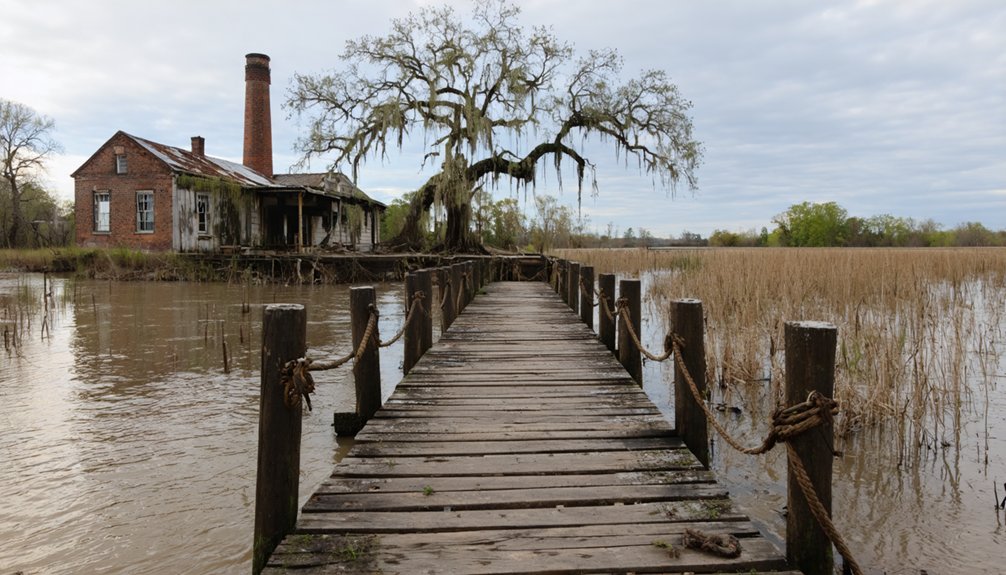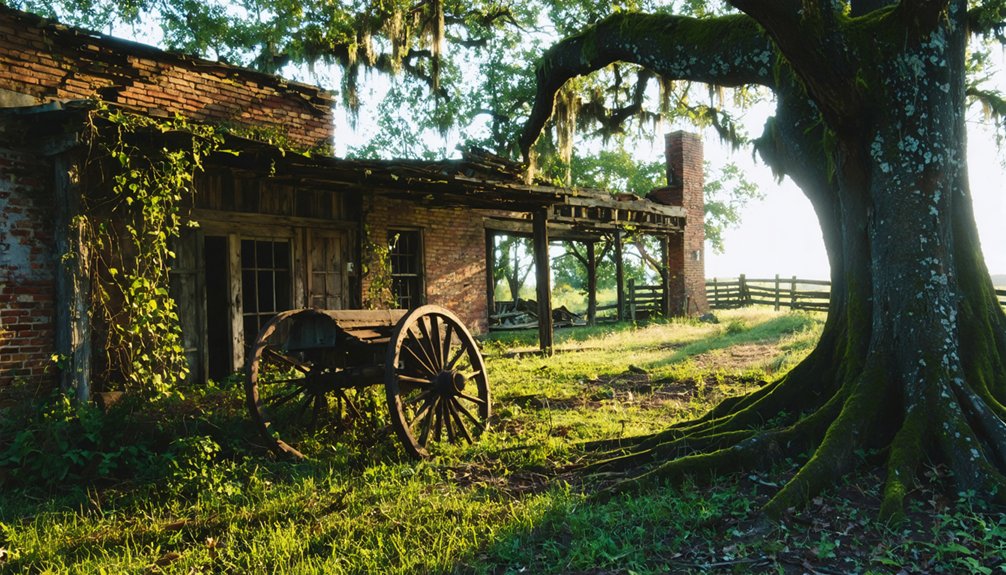You’ll discover Arkansas Post, the state’s most historically significant ghost town, at the confluence of the Arkansas and Mississippi rivers. Established in 1686 by Henri de Tonti, it served as Arkansas Territory’s first capital and an essential trading hub before declining after the capital moved to Little Rock in 1821. During the Civil War, it transformed into Fort Hindman until its surrender in 1863. The site’s rich archaeological findings reveal layers of French colonial and Native American heritage.
Key Takeaways
- Arkansas Post transformed from a thriving territorial capital to a ghost town after losing its capital status to Little Rock in 1821.
- Persistent flooding, erosion, and declining river trade in the 1850s forced residents to abandon buildings and infrastructure.
- The population never exceeded 500 residents, and most structures deteriorated due to environmental challenges and economic decline.
- The site is now preserved as Arkansas Post National Memorial, featuring historical ruins and archaeological remnants of the former settlement.
- The Refeld-Hinman Loghouse, built in 1877, remains as one of the few standing structures from the post-decline period.
The Birth of a French Trading Post
In the summer of 1686, Henri de Tonti established Arkansas Post near the confluence of the Arkansas and Mississippi rivers, marking France’s first settlement west of the Mississippi.
You’ll find this pioneering French settlement was strategically positioned near the Quapaw village of Osotouy, where Tonti built a single wooden house and fence as a reward for his role in La Salle’s 1682 expedition.
Originally named “aux Arcs,” meaning “at the home of the Arkansas,” the post quickly became essential for French-Native alliances. The Quapaw people embraced the settlement, providing critical supplies and military support that guaranteed its survival. However, the post faced early challenges as the Quapaw lacked interest in beaver hunting, which hampered the fur trade operations.
The Quapaw tribe’s vital support and alliance with Arkansas Post ensured the French settlement’s endurance in early colonial America.
While primarily serving as a trading post exchanging French goods for beaver furs, Arkansas Post also hosted the region’s first documented Christian services and became a cornerstone for French colonial expansion. The site later flourished as a vital military outpost during the Chickasaw Wars of 1749.
Strategic Military Significance
You’ll find Arkansas Post’s military significance spans multiple conflicts, from its role in the Revolutionary War’s westernmost skirmish to its strategic position controlling essential river networks.
During the Civil War, the Confederates transformed this location into Fort Hindman, an eight-sided earthwork fortress designed to protect Little Rock and disrupt Union supply lines along three major waterways.
The fort’s capture by Union forces in 1863 eliminated a key Confederate stronghold and proved pivotal to the Federal campaign for control of the Mississippi River system.
The site’s military importance was evident as early as 1732 when French forces established a fortified military post near Quapaw villages to defend against tribal raids and rival colonial powers.
Captain John Colbert led a mixed force attack on the Spanish Fort Carlos III in 1783, marking one of the last Revolutionary War battles in North America.
Revolutionary War Frontier Post
Located at the strategic confluence of the Arkansas and Mississippi Rivers, Arkansas Post emerged as an important military stronghold during the American Revolutionary War under Spanish control.
Under Captain Balthazar de Villiers’ command, you’d find Spanish forces working alongside American Patriots to maintain critical supply lines along the Mississippi River.
The post’s significance peaked during the 1783 Colbert Raid, the westernmost Revolutionary War battle, where Spanish defenders and their Quapaw allies successfully repelled British-aligned forces and Chickasaw warriors.
Through military alliances with Native American tribes and its role as a communication hub, Arkansas Post helped secure the western frontier for Spanish and American interests.
You’ll appreciate how this frontier outpost protected essential trade routes while projecting Spanish influence deep into contested territories.
Originally established by Henri de Tonti in 1686, the post served as a crucial defensive position for over a century.
The site later became a significant battleground when Union forces captured the fort during the American Civil War in 1863.
Confederate Fort Hindman Defense
Perched atop a 25-foot bluff overlooking a strategic hairpin turn in the Arkansas River, Fort Hindman emerged as a critical Confederate stronghold during the Civil War.
The fort’s commanding position allowed Confederate forces to maintain crucial control over river traffic and launch disruptive raids against Union supply lines along the Mississippi River. The capture of the Union supply ship demonstrated the effectiveness of these raids.
You’ll find these key elements of Confederate strategy at Fort Hindman:
- Approximately 4,900 troops, primarily Texas cavalry serving as infantry, defended the fortification
- Strategic earthworks and rifle pits surrounded the fort’s perimeter
- Artillery positions controlled nearly a mile of river passage in both directions
- Confederate naval operations, including successful raids on Union vessels, were launched from this base
This defensive position proved essential to protecting Confederate interests and challenging Union advances into Arkansas territory.
Under the leadership of Brigadier General Churchill, the fort maintained its defensive capabilities until its eventual surrender to Union forces in January 1863.
River Control Operations
While Fort Hindman’s physical defenses proved formidable, the Confederate Army’s control of this strategic point along the Arkansas River yielded far-reaching military advantages.
You’ll find that this position enabled them to disrupt Union river navigation and challenge their Mississippi River strategy, while simultaneously protecting essential Confederate supply logistics to Little Rock, a significant manufacturing center.
The Confederates enhanced their control by implementing defensive measures including log pilings and river obstructions, forcing Union vessels to navigate treacherous waters.
Through this stronghold, they maintained crucial steamboat routes for troop movements and supply distribution. The fort, constructed by Colonel John Dunnington in 1862, featured a square design with four bastions that reinforced its defensive capabilities.
The Union’s Eads gunboats launched a devastating bombardment against the fort’s defenses before ground forces could begin their assault.
However, you’ll note that Union forces recognized the critical importance of wresting control from Confederate hands, as dominating the Arkansas River would effectively sever Confederate supply chains and open a clear path to Little Rock.
Rise as Arkansas Territory’s First Capital
As you explore Arkansas Post’s political ascension, you’ll find its designation as the Territory’s first capital in 1819 marked a pivotal transformation from trading post to governmental center.
The settlement’s strategic location at the confluence of two major rivers helped it grow into the region’s largest community, where William Montgomery’s tavern hosted the first Territorial General Assembly in 1820.
Beyond housing government functions, the riverside capital attracted key institutions like the Arkansas Gazette newspaper and numerous commercial enterprises, though its total population never exceeded 500 residents.
Early Political Hub Emerges
When Arkansas Territory was established in 1819, Arkansas Post emerged as its first capital, marking a pivotal moment in the region’s political development.
You’ll find that the governance structure centered around a territorial legislature, with William Miller serving as the first governor. The political landscape would soon see the rise of powerful political factions, especially the Conway and Sevier families.
Key developments during Arkansas Post’s tenure as capital included:
- The first Arkansas Territorial General Assembly convening in February 1820
- Establishment of formal administrative offices near the river confluence
- Creation of essential territorial laws and regulations
- Formation of initial governmental departments and positions
Despite its promising start as a political center, the post’s environmental challenges and remote location ultimately led to the capital’s relocation to Little Rock in 1821.
Riverside Settlement’s Swift Growth
Thanks to its strategic position at the confluence of the Arkansas and Mississippi Rivers, Arkansas Post experienced remarkable growth during the early territorial period.
You’ll find that by 1819, this settlement had transformed into the region’s largest city, driven by a significant population influx and robust economic expansion. The riverside location proved ideal for steamboat transportation, making it an essential hub for cotton trade between New Orleans and Pittsburgh.
As Arkansas County’s capital in 1813 and later the territory’s first capital, you’d have witnessed well-stocked stores, bustling trading houses, and a thriving cultural center.
The settlement’s prosperity drew from surrounding agricultural lands, while its role in territorial government affairs solidified its position as the region’s commercial and political epicenter.
Commerce and River Trade Dominance

The strategic location of Arkansas Post at the confluence of the Arkansas and Mississippi Rivers established its dominance in regional commerce during the late 17th century.
Arkansas Post’s prime position where two mighty rivers meet created a powerful trade center in late 1600s colonial America.
You’ll find that this essential hub controlled major trade routes, fostering economic diversification through its connections with Native American tribes and European settlers.
- As a thriving river port, Arkansas Post facilitated extensive fur trading with the Quapaw, Caddo, and Osage nations.
- Your goods could reach distant markets via steamboat commerce, with regular shipments of cotton and corn to New Orleans.
- You’d witness a bustling exchange of pelts, agricultural products, and pecans moving through the port’s numerous ferry crossings.
- During its peak, you could capitalize on both French and Spanish trade influences, making it the economic powerhouse of the Arkansas Territory.
Civil War Impact and Fort Hindman
During the American Civil War, Fort Hindman emerged as a critical Confederate stronghold at Arkansas Post, where its commanding position atop a 25-foot bluff provided strategic control over the Arkansas River.
You’d find nearly 5,000 Confederate troops stationed there under Brig. Gen. Thomas J. Churchill‘s command, using the fort as a base to raid Union supply lines along the Mississippi River.
The fort’s dominance wouldn’t last long. In January 1863, Union forces launched a massive assault with 32,000 troops and naval support.
After three days of intense fighting, with Union gunboats bombarding the fort while infantry advanced on land, the Confederate defenders faced overwhelming odds.
The battle ended with Churchill’s surrender, resulting in nearly 4,800 Confederate casualties and marking a significant Union victory that eliminated a major threat to their Mississippi operations.
The Gradual Exodus

Following its brief tenure as Arkansas’s territorial capital, Arkansas Post experienced a devastating cascade of setbacks that would trigger its transformation into a ghost town.
You’ll find that the settlement’s decline wasn’t sudden but rather a gradual exodus spanning several decades, marked by these significant developments:
- The relocation of the territorial capital to Little Rock sparked an immediate economic decline as businesses and political institutions abandoned the post.
- River trade diminished dramatically by the 1850s, leaving the once-bustling port with diminishing commercial prospects.
- Persistent flooding and erosion of the Arkansas River banks made maintaining permanent structures increasingly difficult.
- The population shift accelerated as the post’s commercial infrastructure crumbled, leaving behind empty buildings and abandoned enterprises that would eventually fade into the landscape.
Archaeological Discoveries and Remnants
Rich archaeological discoveries at Arkansas Post have revealed a complex tapestry of colonial and indigenous life spanning multiple centuries.
Archaeological techniques employed since 1956 have unearthed French colonial village remains, including distinctive poteaux-en-terre building patterns and thousands of colonial artifacts.
Excavations reveal French colonial life through poteaux-en-terre construction methods and abundant artifacts from Arkansas Post’s historic settlement.
You’ll find evidence of cultural fusion at the Menard-Hodges Site, where excavations uncovered Quapaw burials containing both Native artifacts and European trade items.
The site’s material culture tells a story of diverse influences through recovered items like English Borderware, French Saintonge bowls, and German stoneware.
While erosion and flooding have damaged many physical remnants, especially near the waterfront, northern portions of the site continue to yield intact archaeological features that document the intersection of Native American, French, Spanish, and American cultures.
Preservation Efforts and National Memorial Status

The preservation of Arkansas Post’s remarkable heritage took a significant step forward in 1960 when the site earned National Memorial status under the National Park Service.
Despite preservation challenges, you’ll find this historical treasure maintains its memorial significance through careful conservation efforts and educational programming.
- You can explore well-maintained trails and picnic areas while accessing prime fishing spots, all designed to balance public enjoyment with environmental protection.
- You’ll discover Confederate trenches that remain as tangible links to the Civil War era.
- You can participate in guided tours that bring to life over 300 years of French, Spanish, and American history.
- You’ll benefit from the memorial’s museum and visitor center, which showcase artifacts and exhibits highlighting the site’s role in shaping American frontier history.
Walking Through History Today
Today’s visitors to Arkansas Post can immerse themselves in over three centuries of American frontier history through an extensive network of interpretive walking trails.
You’ll discover the historical significance of this former French settlement while exploring Confederate trenches, the 1783 Colbert Raid site, and remnants of the territorial capital.
The visitor center’s exhibits and 20-minute film provide context for your journey through time, while interactive displays let you handle authentic fur-trading artifacts.
As you walk the grounds, you’ll encounter both paved and natural paths that showcase the area’s rich cultural heritage, from the Quapaw village of Osotouy to Civil War battlefields.
The museum complex’s five buildings, including the 1877 Refeld-Hinman Loghouse, further illuminate life in Arkansas’ Grand Prairie region.
Frequently Asked Questions
What Were the Daily Wages of Workers at Arkansas Post?
You’ll find wage discrepancies at Arkansas Post reflected labor conditions, with workers earning $0.75-$1.50 daily for basic tasks, while skilled craftsmen commanded $2.00-$3.00 per day in the 19th century.
How Many Deaths Occurred During the Various Floods at Arkansas Post?
While exact flood fatalities at Arkansas Post aren’t documented, you’ll find the area was impacted by major floods in 1777, 1778, and 1927, with the latter causing 98 deaths across Arkansas.
What Native American Ceremonies Were Performed at the Quapaw Village Site?
You’ll find the Quapaw rituals centered on the Calumet Ceremony, where they shared sacred pipes, performed buffalo dances, conducted Earth-Sky moiety ceremonies, and offered spiritual sacrifices to waterways for safe passage.
Which Rare Plant Species Were Native to the Arkansas Post Area?
You’ll find endangered flora of ecological significance including Indian pink, Ozark trillium, four-leaf milkweed, American smoketree, and water-chinquapin thriving in the area’s diverse woodland and wetland habitats.
What Happened to the Post’s Residents During Major Disease Outbreaks?
You’ll find that disease impact devastated Post residents through recurring epidemics of smallpox, cholera, and yellow fever, forcing quarantines and evacuations that contributed to the area’s gradual population decline.
References
- https://en.wikipedia.org/wiki/Arkansas_Post
- https://www.nps.gov/arpo/learn/historyculture/arkansas-post-timeline-prehistory-1763.htm
- https://arkansasfrontier.com/ghost-towns-in-arkansas/303766/
- https://npshistory.com/series/archeology/scrc/12/report.pdf
- https://www.uaex.uada.edu/environment-nature/musings-on-nature-blog/posts/ghost-towns.aspx
- https://en.wikipedia.org/wiki/List_of_ghost_towns_in_Arkansas
- https://www.nps.gov/arpo/learn/historyculture/index.htm
- https://www.bunnyplayshere.com/post/the-story-of-the-arkansas-ghost-town
- https://encyclopediaofarkansas.net/entries/arkansas-post-3/
- https://www.ebsco.com/research-starters/sports-and-leisure/arkansas-post



